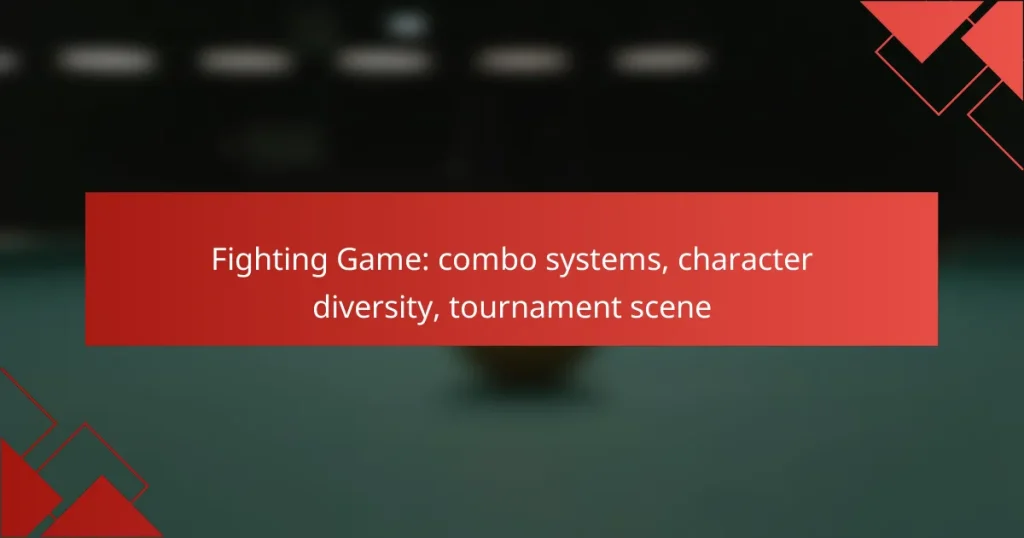Fighting games are defined by their intricate combo systems, which enable players to execute complex sequences of attacks for maximum damage. Character diversity enhances this experience, offering a wide range of unique fighters, each with distinct abilities and playstyles. This variety not only enriches gameplay but also shapes the competitive tournament scene, where players from around the world showcase their skills in diverse formats and rules.
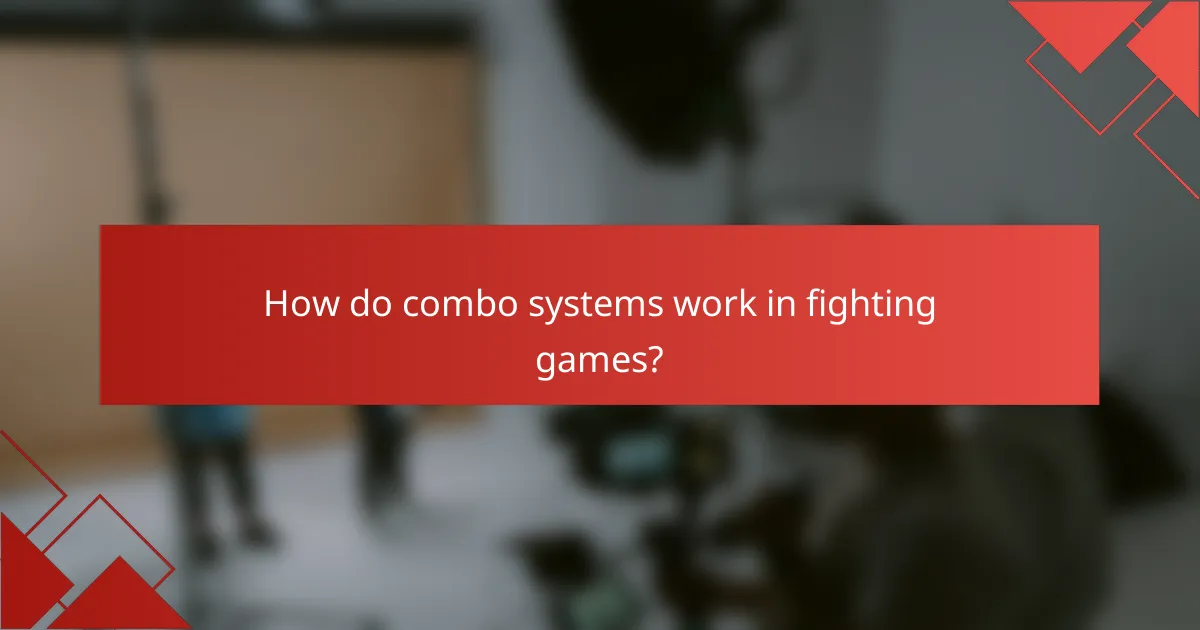
How do combo systems work in fighting games?
Combo systems in fighting games allow players to chain together a series of attacks to maximize damage and create strategic opportunities. These systems rely on precise input timing and character-specific moves, enabling players to execute complex sequences that can vary significantly between different games and characters.
Input timing and sequence
Input timing is crucial in executing combos effectively. Players must input commands within a specific window, often measured in milliseconds, to link attacks seamlessly. The sequence of inputs can determine whether a combo is successful or fails, making practice essential for mastering each character’s unique timing.
Common pitfalls include mistiming inputs or using the wrong sequence, which can lead to dropped combos or counterattacks from opponents. Players should focus on developing muscle memory for their preferred characters to improve their execution speed and accuracy.
Types of combos: basic and advanced
Combos can be categorized into basic and advanced types. Basic combos typically involve simple sequences of light and medium attacks that are easy to learn and execute, making them accessible for beginners. These combos often serve as the foundation for more complex strategies.
Advanced combos, on the other hand, require a deeper understanding of the game mechanics, including juggle states and special moves. These combos may incorporate techniques like canceling, linking, and using specific character abilities to extend damage output. Players should gradually transition from basic to advanced combos as they gain experience.
Notable games with unique combo systems
Several fighting games are renowned for their distinctive combo systems. For instance, “Street Fighter” series emphasizes link combos and canceling techniques, allowing players to create intricate sequences. In contrast, “Tekken” features a 3D movement system that enables juggle combos, where players can launch opponents into the air and continue attacking.
Another example is “Guilty Gear,” which incorporates a mechanic called “Roman Cancel,” allowing players to interrupt their moves and extend combos creatively. Each game’s unique approach to combo systems influences player strategies and character selection, contributing to the diversity of the competitive scene.
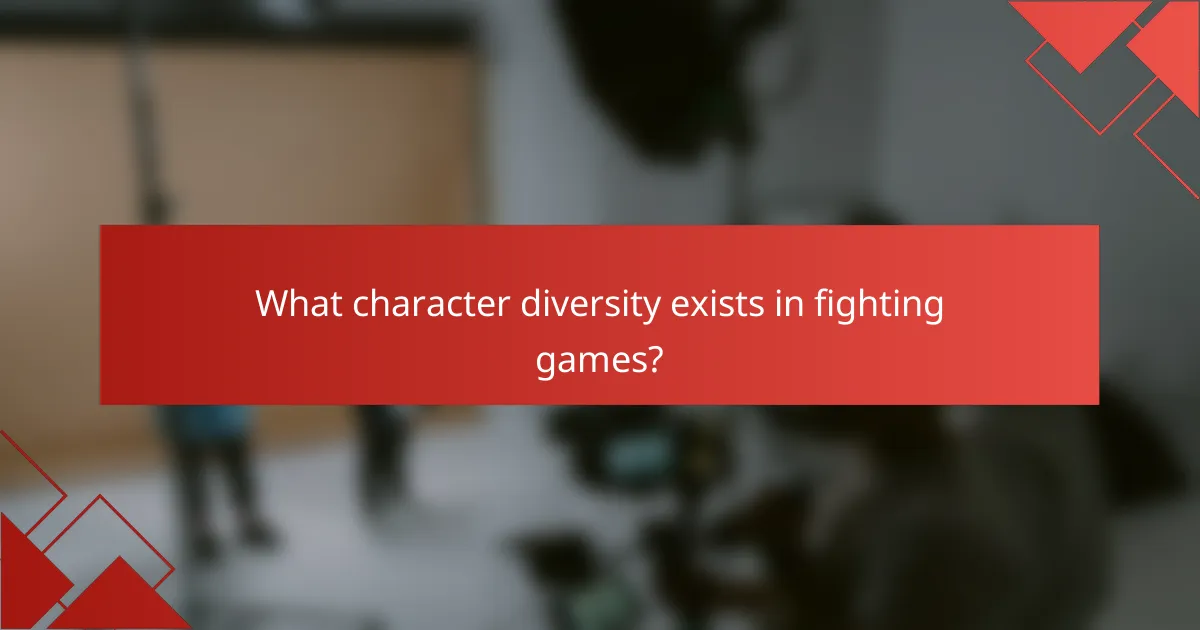
What character diversity exists in fighting games?
Character diversity in fighting games refers to the variety of playable characters, each with unique abilities, fighting styles, and attributes. This diversity enriches gameplay, allowing players to choose characters that fit their preferred strategies and playstyles.
Character archetypes and roles
Fighting game characters often fall into distinct archetypes, such as grapplers, rushdown fighters, zoners, and hybrid types. Grapplers excel in close-range combat and can execute powerful throws, while zoners control space with projectiles and long-range attacks. Understanding these roles helps players select characters that complement their strategies.
Each archetype influences how players approach matches. For example, a grappler may focus on closing the distance quickly, while a zoner will prioritize keeping opponents at bay. This dynamic creates a rich tactical environment where players must adapt to their opponent’s character type.
Examples of diverse character rosters
Many popular fighting games showcase diverse character rosters. For instance, “Street Fighter” features characters like Ryu, a balanced fighter, and Zangief, a powerful grappler. Similarly, “Tekken” includes characters such as Jin, a versatile fighter, and King, who specializes in grappling techniques.
Games like “Mortal Kombat” and “Guilty Gear” also highlight character diversity, offering unique abilities and fighting styles. This variety not only enhances player engagement but also fosters a competitive scene where different characters can shine.
Impact of character design on gameplay
Character design significantly impacts gameplay mechanics and strategies. Characters with unique abilities can create specific matchups that require players to adapt their tactics. For example, a character with strong defensive capabilities may force an aggressive player to rethink their approach.
Moreover, character balance is crucial in competitive play. Developers often tweak characters to ensure no single character dominates the scene, promoting a healthy competitive environment. Players should stay informed about balance changes to optimize their character choices in tournaments.
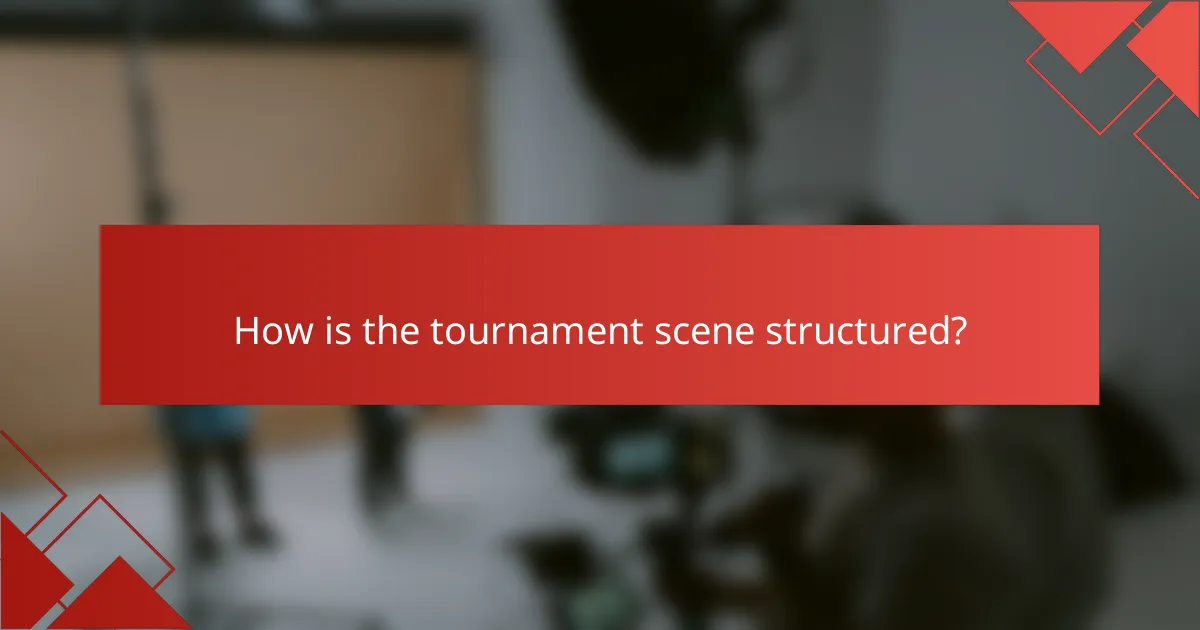
How is the tournament scene structured?
The tournament scene for fighting games is organized around various competitive events that bring together players from different regions. These tournaments often feature a range of formats, rules, and character diversity, allowing for a rich competitive landscape.
Major fighting game tournaments in the UK
The UK hosts several prominent fighting game tournaments, including the London-based EGX and the UK Championship. These events attract both local and international talent, showcasing a variety of games like Street Fighter, Tekken, and Guilty Gear.
In addition to these larger tournaments, smaller regional events occur regularly, providing opportunities for up-and-coming players to compete. These grassroots tournaments help foster community engagement and skill development.
Notable competitive formats and rules
Tournaments typically follow a double-elimination format, where players must lose twice to be eliminated. This structure allows for a more forgiving experience, giving players a chance to adapt and learn from their losses.
Rules often include character lock, where players must stick with their chosen character throughout the tournament, and time limits for matches, usually set between 90 seconds to 3 minutes. These regulations ensure fair play and maintain the pace of the competition.
Top players and their strategies
Top players in the UK, such as Problem X and Shakz, are known for their unique strategies and mastery of character mechanics. They often utilize a mix of aggressive and defensive tactics, adapting their playstyle based on their opponents.
Successful players emphasize the importance of practice and understanding matchups, often studying their opponents’ gameplay to exploit weaknesses. This analytical approach, combined with technical skill, is crucial for success in high-stakes tournaments.

What are the prerequisites for entering tournaments?
To enter fighting game tournaments, players typically need a certain skill level and the right equipment. Understanding these prerequisites can help ensure a smoother experience when competing.
Skill level requirements
Most tournaments have varying skill level requirements, often categorized from beginner to advanced. It’s essential to assess your own abilities honestly; many events welcome players of all skill levels, while others may require a minimum rank or experience in competitive play.
Participating in local tournaments can be a great way to gauge your skill and gain experience. Engaging with the community through online platforms can also provide insights into where you stand compared to other players.
Equipment and setup needed
Having the right equipment is crucial for tournament participation. Players generally need a reliable gaming console or PC, a quality controller or arcade stick, and a stable internet connection if the event is online. Some tournaments may also require specific hardware or software, so checking the event rules is advisable.
Additionally, consider bringing a backup controller and any necessary cables to avoid technical issues during the competition. Familiarizing yourself with the tournament setup, including screen resolution and input lag, can also enhance your performance.
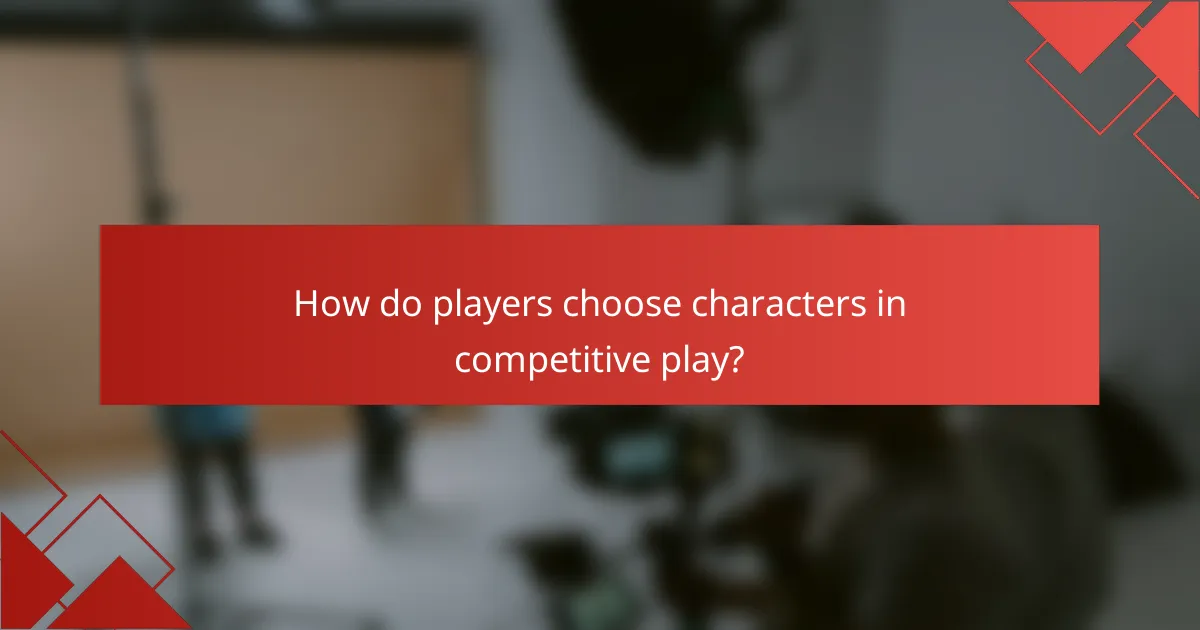
How do players choose characters in competitive play?
Players choose characters in competitive fighting games based on a mix of character strengths, personal play style, and the current game meta. Understanding these factors helps players select characters that fit their strategies and improve their chances in tournaments.
Meta analysis and character viability
Meta analysis involves evaluating which characters are currently performing well in the competitive scene. This can change frequently due to game updates, balance patches, and emerging strategies. Players often refer to tier lists that categorize characters from top-tier to low-tier based on their effectiveness in high-level play.
For example, a character that excels in speed and combo potential might be ranked higher than one with slower moves but stronger defensive capabilities. Players should keep an eye on tournament results and community discussions to gauge which characters are thriving in the current meta.
Player preferences and play styles
Individual player preferences significantly influence character choice. Some players may prefer aggressive, rushdown characters that require quick reflexes, while others might favor defensive characters that focus on countering opponents. Understanding one’s own play style is crucial for selecting a character that feels comfortable and intuitive.
Additionally, players should consider the learning curve associated with each character. Characters with complex mechanics may offer high rewards but require more practice to master. Balancing personal enjoyment with competitive viability can lead to better performance in tournaments.
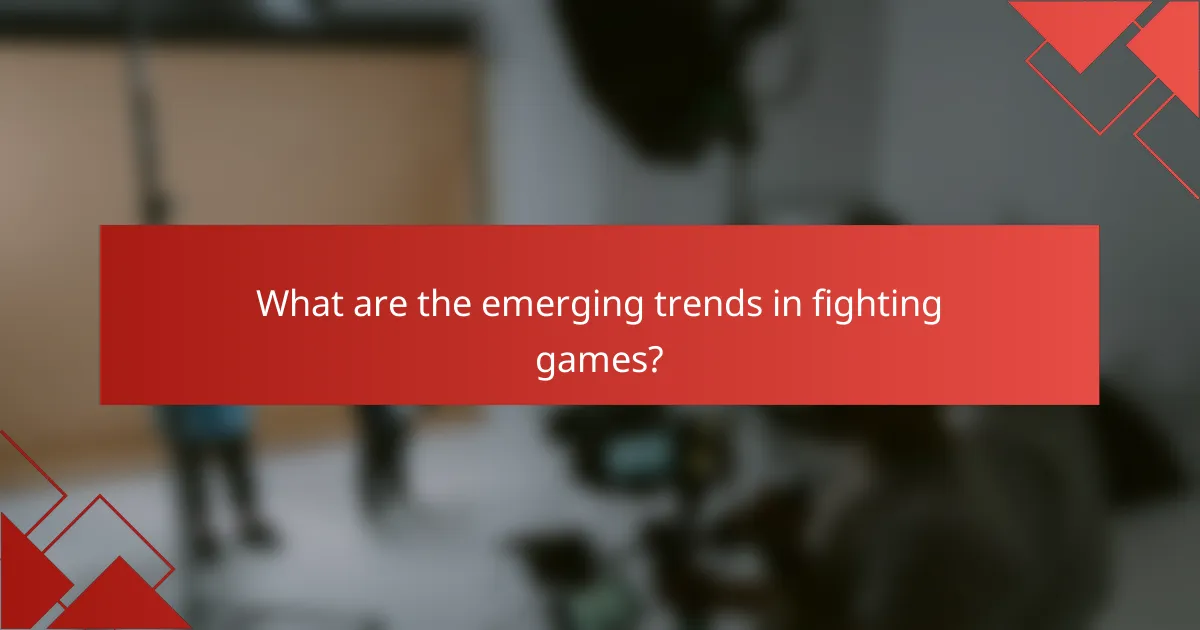
What are the emerging trends in fighting games?
Emerging trends in fighting games include the integration of online play and esports, innovations in game mechanics, and increased community engagement. These trends are reshaping how players interact with games and each other, enhancing both competitive and casual experiences.
Integration of online play and esports
The integration of online play has become a cornerstone of modern fighting games, allowing players to compete globally without geographical limitations. This shift has led to the rise of esports, where tournaments offer substantial prizes and attract large audiences.
Developers are focusing on improving netcode to ensure smooth online experiences, with rollback netcode being a popular choice for reducing latency. Players should prioritize games with robust online features to maximize their competitive potential.
Innovations in game mechanics
Innovative game mechanics are redefining gameplay dynamics in fighting games. Features like adaptive AI, unique combo systems, and character-specific mechanics enhance player engagement and strategy.
For instance, some titles now include mechanics that allow for more fluid combo execution or introduce new ways to counter opponents’ moves. Players should explore these mechanics to gain a competitive edge and find their preferred playstyle.
Community engagement and content creation
Community engagement has surged, with players actively participating in content creation through streaming, tutorials, and fan art. This involvement fosters a sense of belonging and encourages new players to join the scene.
Developers are increasingly supporting community initiatives, such as hosting tournaments or featuring user-generated content. Players can benefit from engaging with the community by sharing strategies and learning from others, enhancing their overall experience in the fighting game ecosystem.
